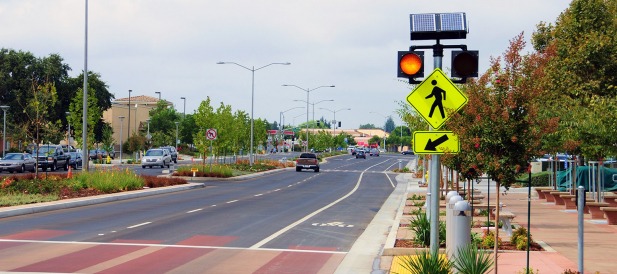Vancouver, BC – (February 10, 2004) – Carmanah Technologies Corporation is pleased to introduce one of the world’s most advanced pedestrian crossing beacons to the North American market.
The Model R820 Pedestrian Beacon is a fully self-contained, solar-powered LED crosswalk signal. Key advantages include: wireless installation in as little as 30 minutes, minimal capital cost, zero operational cost, a “green” power source, and immunity to electrical blackouts.
“We are pleased to bring the latest LED technology to the multi-billion dollar North American roadways market,” states Art Aylesworth, Carmanah’s CEO. “Our solar pedestrian beacon enables municipalities to provide lighted crosswalks and school zones at a significantly lower cost than was previously possible, improving safety while significantly reducing energy consumption and cutting costs.”
Introduced to the U.K. and European markets for extensive field trials in 2001, Carmanah’s Model R820 is the first product of its kind in the world. Bristol, England, installed 150 units as school crossing beacons in the fall of 2002 into the challenging English solar environment. In April 2002, these school crossing lights were voted runner up in the category “INNOVATIONS: Contribution to Sustainability” as part of the UK Lighting Industry Design Awards.
In the first quarter of 2004, the City of Victoria, British Columbia, will become the first North American city to install the R820, with many other clients to follow. A U.S. patent is pending.
Accident statistics highlight the need for this product. Most of the approximately 5,000 pedestrian fatalities that occur every year in the U.S. happen at night, at non-intersection locations without proper crosswalks or lighting.
LED lights, which use up to 90 percent less power and last longer than incandescent lightbulbs, are the latest trend in traffic lighting. Retrofitting existing traffic signals with LEDs can pay for itself within a few years through reduced maintenance and electricity costs. Carmanah’s solar-powered LED technology offers the added advantage of a stand-alone system with no external wiring. Installation costs are much lower and operational costs are zero for the product’s five-year lifespan. Carmanah’s lights often pay for themselves upon installation.

“Lights that operate independently of the power grid are not only less expensive, they are also more reliable and safer,” said Aylesworth. “During the East Coast blackout of 2003, Carmanah’s lights kept shining.” Electricity demand growth and aging power grids are prompting traffic engineers to seek alternative power systems. In 2001, for example, Sacramento County, California, spent $500,000 to convert to LED traffic signals with battery backups at 120 intersections.
Carmanah Technologies recently unveiled the Model R820 Pedestrian Beacon at the American Traffic Safety Services Association (ATSSA) Convention and Traffic Expo, from January 30 to Feb 3, 2004, in San Antonio, Texas. Carmanah also displayed its full line of solar LED roadway and construction lights, including directional and 360-degree marking lights, bi-directional hazard post markers and sign enhancing lights.